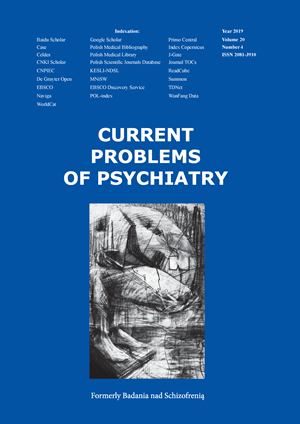The influence of the family on the formation of eating and weight disorders
DOI:
https://doi.org/10.2478/cpp-2019-0021Keywords:
alimentary family, psychosomatic family, eating disorders, weight disorders eating behaviour, parental control tacticsAbstract
The аim is to study family influence on formation of eating and weight disorders. The concept of an “alimentary family” is defined as a family with dysfunctional, disharmonious relationships, which is a prerequisite for emergence and support of distorted patterns of eating behaviour, leading in the future to children’s eating and weight disorders.
Methods: The research was carried out using the method of a thematic retrospective analysis (MTRA)-food, which is a variant of the narrative method, the questionnaire "Parental convictions and control tactics as for eating behaviour of their children during food taking". The data was processed by the content analysis method; Fisher's φ-criterion was used to compare differences between the groups.
Results: The research has allowed us to clarify eating behavioural characteristics and to identify the “roots” of eating disorders. Various forms of forcing at eating, direct and indirect ways of making children to eat or blocking of eating are manifested in ignoring of children’s taste preferences, their desire and readiness to eat. Parents often use manipulative techniques influencing children’s eating behaviour (encouragement, inducement, reward promises, approval, recognition, warning, or switching attention), direct means of influence (coercion: prohibition, restriction, rejection, destructive criticism, intimidation, deprivation from various pleasures). There is the statistical confirmation that parents’ use of manipulative means and/or direct coercion towards their children during eating predetermines formation of pathological processes of corporeality, attitudes and psychological mechanisms stipulating eating disorders.
Conclusions: The research results indicate necessity to develop psychotherapeutic programs for people with eating disorders, as well as programs to help parents improve family relationships and, accordingly, to apply correctional effects on their children.
References
1. Biletskaya MP. Family 1. Biletskaya MP. Family psychotherapy of children with psychosomatic disorders. St. Petersburg; Speech: 2010. Russian.
2. Salmina-Hvostova OI. Eating Disorders. Journal of Public Health of Chuvashia. 2010; 1. http://giduv.com/journal/2010/1/rasstrojstva_pischevogo.
3. Karnik S., Kanekar A. Childhood obesity: a global public health crisis. Int J Prev Med. 2012; 3(1): 1-7. https://www.ncbi.nlm.nih. gov/pmc/articles/PMC3278864/
4. Cassels С. Anorexia: key mortality risk factor revealed. Medscape Medical News: Psychiatry news. 2013: 917–925.
5. Sabel AL., Rosen E., Mehler P. Severe anorexia nervosa in males: clinical presentations and medical treatment. Eating disorders. 2014; 22(3): 209–220. https://doi.org/10.1080/10640266.2014.890459.
6. Safer DL., Adler S., Masson PC. The DBT Solution for emotional eating: a proven program to break the cycle of bingeing and outof-control eating. New York–London; The Guilford Press: 2018.
7. Abu Baker NN., Al-Ali N., Al-Ajlouni R. Attitudes of Jordanian Adolescent Students Toward Overweight and Obesity. Open Nurs J. 2018; 12:15-25. https://doi.org/10.2174/1874434601812010015.
8. Hail L., Le Grange D. Bulimia nervosa in adolescents: prevalence and treatment challenges. Adolescent health, medicine and therapeutics. 2018; 4;9:11-16. https://doi.org/10.2147/AHMT.S135326
9. Ball K., Lee С. Psychological stress, coping, and symptoms of disordered eating in a community sample of young Australian women. Int J Eat Disord., 2002; 31(1):71-81. https://doi.org/10.1002/eat.1113
10. Fairburn CG., Harrison PJ. Eating disorders. The Lancet, 2003; 361 (9355): 407-416. https://doi.org/10.1016/S0140-6736(03)12378-1.
11. Minuchin S. Families and Family Therapy. New York: Routledge: 2008. Russian.
12. Ammon G. Psychosomatic Therapy. Saint Petersburg: Speech: 2000. Russian.
13. Chen JL., Guo J., Esquivel JH., Chesla CA. Like Mother, Like Child: The Influences of Maternal Attitudes and Behaviors on Weight-Related Health Behaviors in Their Children. J Transcult Nurs . 2017;1:1043659617736883. https://doi.org/10.1177/1043659617736883
14. Köhler M., Emmelin M., Rosvall M. Parental health and psychosomatic symptoms in preschool children: A crosssectional study in Scania, Sweden. Scand J Public Health. 2017; 45(8):846-853. https://doi.org/10.1177/1403494817705561.
15. Shebanova VI. Phenomenology of food behavior in the continuum «norm-pathology». Kherson; Publishing House of Vyshemirsky V.S.: 2016. Ukraine.
16. The International Statistical Classification of Diseases and Related Health Problems. 10th revision (ICD-10). World Health Organization (2010). https://icd.who.int/browse10/2016/en
17. Diagnostic and Statistical Manual of Mental Disorders, Fifth Edition (DSM-5). Arlington, VA: American Psychiatric Publishing, 2013
18. Zubar NM. Fundamentals of Physiology and Food Hygiene: Textbook. Kiev: Center for Educational Literature: 2010. Ukraine.
19. Tsiring DA. Psychological functions of personal helplessness Bulletin of Tomsk State University. 2012; 357: 173-175. Russian.
20. Maier SF., Seligman ME. Learned helplessness at fifty: Insights from neuroscience. Psychol Rev. 2016; 123(4): 349-367. https://doi.org/10.1037/rev0000033.
21. Salcioglu E., Urhan S., Pirinccioglu T., Aydin S. Anticipatory fear and helplessness predict PTSD and depression in domestic violence survivors. Psychol trauma. 2017; 9(1): 117-125. https://doi.org/10.1037/tra0000200.
22. Larsen JT., Munk-Olsen T., Bulik CM., Thornton LM., Koch SV., Mortensen PB., et. al. Early childhood adversities and risk of eating disorders in women: A Danish register-based cohort study. Int J Eat Disord.. 2017; 50(12): 1404-1412. https://doi.org/10.1002/eat.22798.
23. Sikora R. Risk behaviors at late childhood and early adolescence as predictors of depression symptoms. Curr Probl Psychiatry, 2016; 17(3): 173-177. https://doi.org/10.1515/cpp-2016-0018
24. Wallis A., Miskovic-Wheatley J., Madden S., Rhodes P., Crosby RD., Cao L., et al. Family Functioning and Relationship Quality for Adolescents in Family-based Treatment with Severe Anorexia Nervosa Compared with Non-clinical Adolescents. Eur Eat Disord Rev.2018 ;26(1):29-37. https://doi.org/10.1002/erv.2562
Downloads
Published
Issue
Section
License
Copyright (c) 2019 Authors

This work is licensed under a Creative Commons Attribution-NonCommercial-NoDerivatives 3.0 Unported License.


